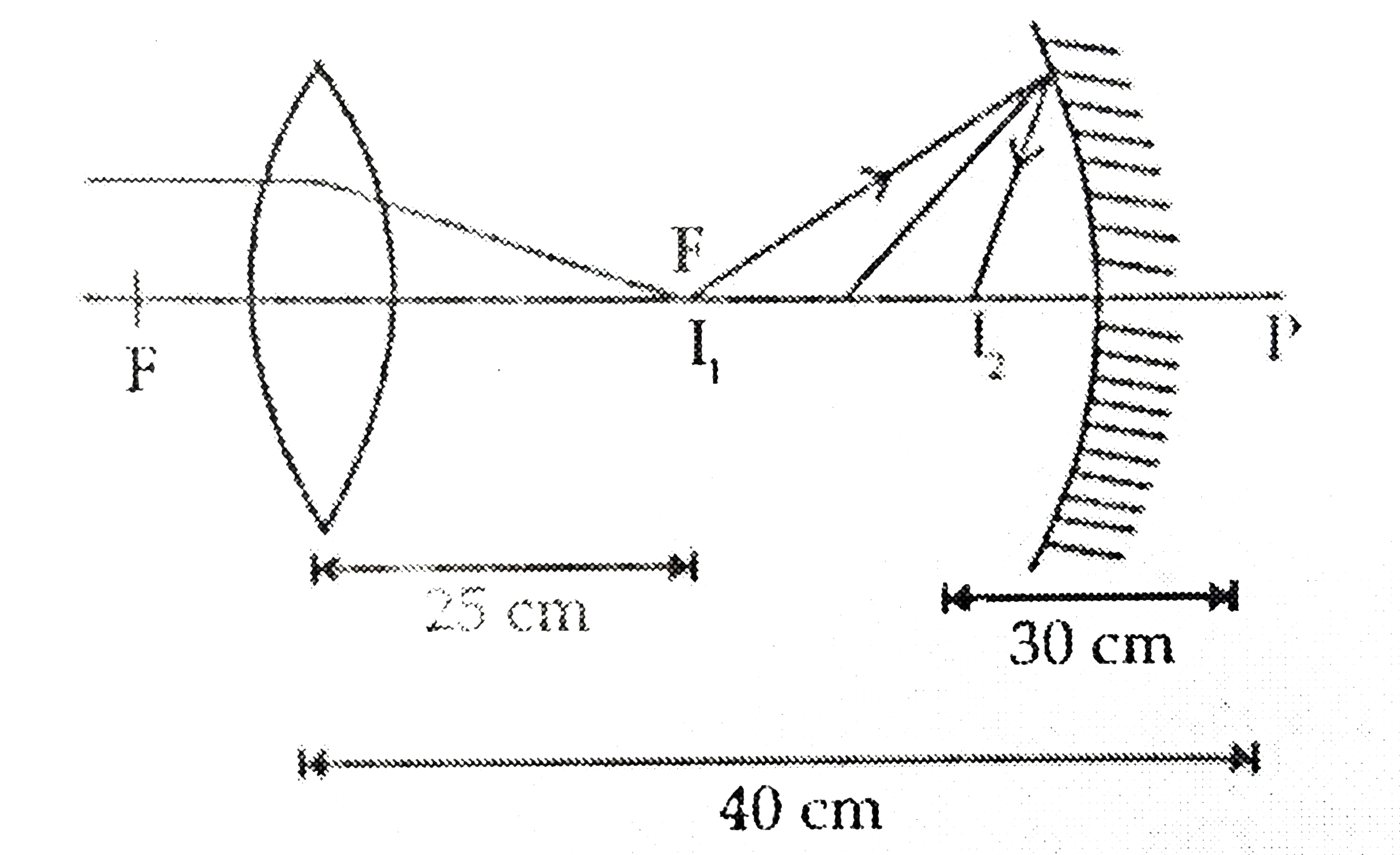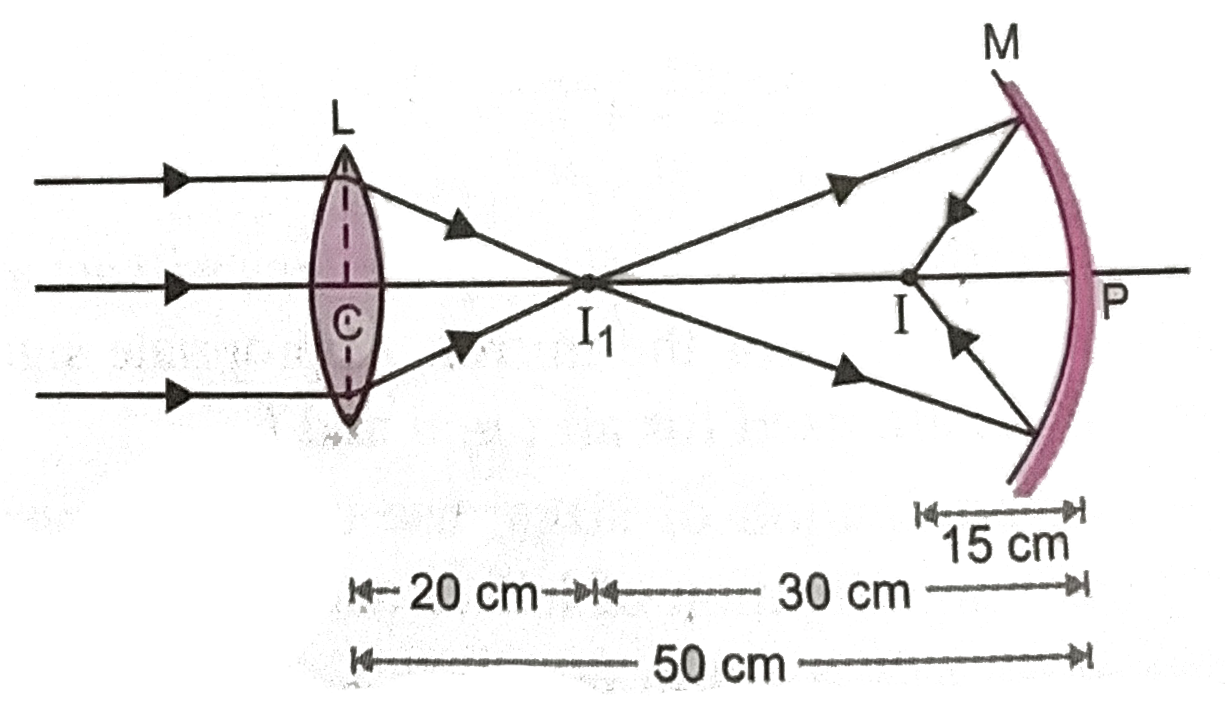A convex lens, of focal length 25 cm, and a concave mirror, of radius of curvature 20 cm. are placed co-axially 4 cm aprat from each other. An incident beam, parallel to the principal axis, is incident on the convex lens. Find the position and nature of the image formed by this combination.

For image l1 :
u=−∝ u=−15cm
1υ−1u=1f 1υ+1u=1f
⇒υ=25cm 1υ=1f−1u=−110+115
⇒υ=−30cm
Real image on same side of mirror.
Topper's Solved these Questions
- BOOK - XII BOARDS PREVIOUS YEARCHAPTER - XII BOARDSEXERCISE - C.B.S.E.CLASS-XII PHYSICS (THEORY) [SET-I] (SECTION-A)5videos
XII BOARDS
- BOOK - XII BOARDS PREVIOUS YEARCHAPTER - XII BOARDSEXERCISE - SECTIONS-B6videos
XII BOARDS
- BOOK - XII BOARDS PREVIOUS YEARCHAPTER - XII BOARDSEXERCISE - SECTION-C55videos
XII BOARDS
- BOOK - XII BOARDS PREVIOUS YEARCHAPTER - SAMPLE PAPER 2019EXERCISE - SECTION D6videos
SAMPLE PAPER 2019
Similar Questions
A convex lens of focal length 20cm and a convex mirror of focal length 10cm are placed co-axially 50cm apart from each other. An incident beam parallel to its principal axis is incideent on the convex lens. Locate the position of final image formed due to the combination.
View SolutionA convex lens of focal length 20cm is placed co-axially with a convex mirrir of radius of curvature 20cm. The two are kept 15cm apart from eachother. A point object is placed 60cm in front of the convex lens. Find the position of the image formed by the combination.
View Solution
Knowledge Check
- Question 1 - Select One
A convex lens of focal length 100 cm and a concave lens of focal length 10 cm are placed coaxialiy at a separation of 90 cm. If a parallel beam of light is incident on convex lens, then after passing through the two lenses the beam
AConvergesBDivergesCRemains parallelDDisappears
A convex lens of focal length 20cm and a convex mirror of focal length 10cm are placed co-axially 50cm apart from each other. An incident on the convex lens. Locate the position of final image formed due to the combination.
 (NCERT Solved Example)View Solution
(NCERT Solved Example)View SolutionA convex lens of focal length 15cm, and a concave mirror of radius of curvature 20cm are placed co-axially 10cm apart. An object is placed in front of convex lens so that there is no parallax between the object and its image formed by the combination. Find the position of the object.
View SolutionA convex lens of focal length 20cm is placed coaxilly with a convex mirror of radius of curvature 20 cm. The two are kept 15 cm apart. A point object is placed 40 cm in front of the convex lens. Find the position of the image formed by this combination. Draw the ray diagram showing the image formation.
View SolutionA concave lens of focal length 20 cm is placed 15 cm in front of a concave mirror of radius of curvature 26 cm and further 10 cm away from the lens is placed an object. The principal axis of the lens and the mirror are coincident and the object is on the axis Find the position and nature of the image.
View SolutionA convex lens of focal length 10 cm is placed coaxially 5 cm away from a concave lens of focal length 10 cm. If an object is placed 30 cm in front of the convex lens, find the position of the final image formed by the combined system.
View SolutionA convex lens of focal length 10 cm is placed coaxially 5 cm away from a concave lens of focal length 10 cm. If an object is placed 30 cm in front of the convex lens, find the position of the final image formed by the combined system.
View SolutionA convex lens of focal length 10cm is placed co-axially 5cm away from a concave lens of focal length 10cm. If an object is placed 30cm in front of the convex lens, find the position of final image formed by the combined system.
View Solution

